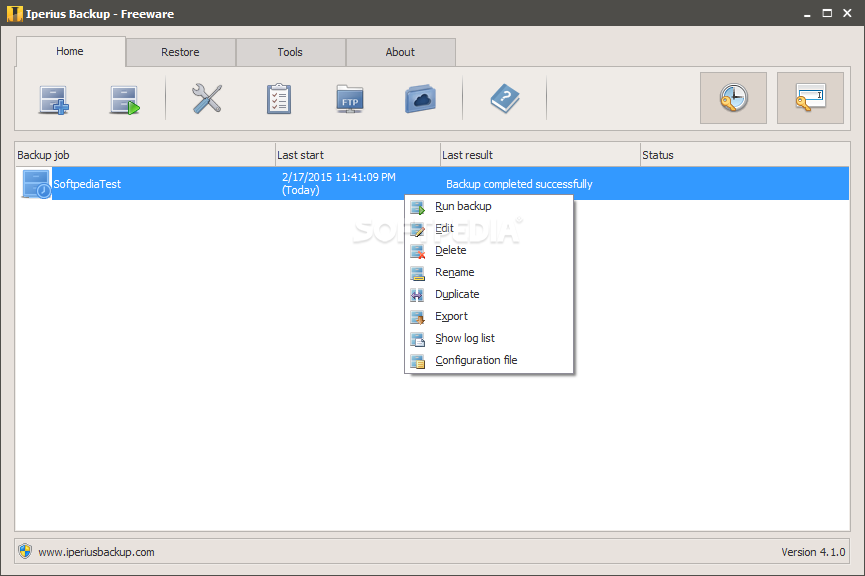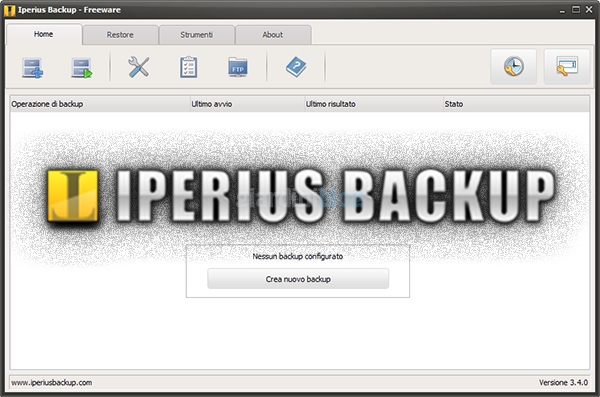

IPERIUS BACKUP FILEHIPPO WINDOWS
It could do a better job of defining and presenting the relationship between sources and destinations, but the mere fact that it’s so versatile in this regard, and that it combines file backup and imaging using non-proprietary containers, puts it in my top three.Iperius is a complete backup utility for Windows that can be used by bothhome users and Company servers (without any time/license limitation). I’m extremely impressed with Iperius Backup’s versatility and performance. To show it, access the system tray icon and select the option to show it. It was easy to guess the similar words, but it does make one wonder what else had been overlooked.Īlso, the backup progress dialog isn’t modal and can easily be hidden behind the main window. Other languages my be different, but there were still buttons in Italian in the log dialog, and possibly other locations. The program that I downloaded wasn’t completely translated to English. Disable the option in the dialog to avoid this. This can under some circumstances induce errors by creating file names that are too long. By default the program will recreate the entire path of the folder or file you’re backing up.

If that’s not an issue for you, use NTFS, which is much faster writing small files.Ī few unusual features to note with Iperius. I run both PCs and Macs, and exFAT lets me use the drive on both platforms. Hopefully, this is not an issue much longer. The only issue I had was with imaging: An image was created properly, but wasn’t copied to my local external hard drive, which Iperius said was likely because the primary destination (external USB drive) was formatted to exFAT and not NTFS. I observed only one glitch in my testing, and it was only in copying a successful imaging operation to the other backup destinations. The integrity of the backups was perfect. For all file-related tasks, including downloading files from FTP and network locations, it performed quickly without, as I mentioned, slowing down my system. I did a number of tests with Iperius, including multiple-action file/image jobs with multiple destinations. You can compare all the Iperius versions on the company’s website. The advanced features are useful, and if you don’t need them, you can continue to use the limited version for free.
IPERIUS BACKUP FILEHIPPO TRIAL
The free version is great for backing up files to local and local network destinations, but it won’t run as a service, perform multiple simultaneous backups, or create recovery boot media as the pay versions will.Īs the single PC license is a mere 29 euros ($32 at the time of this writing), I recommend that you give the 21-day trial a shot. I still used it to back up my PCs to my NAS boxes. FTP (File Transfer Protocol) is the granddaddy of remote file access protocols. There’s even has a fully functional FTP client on board that opens up a remote directory and a local one, then lets you copy back and forth. Iperius’s imaging is powerful and uses the common VHD container format so you can mount the images without the program using Windows or VM software. VHD files are mountable by Windows and various virtual machines (VirtualBox, VMware, etc.) programs, so you’re not reliant upon Iperius to browse them.
IPERIUS BACKUP FILEHIPPO ZIP
It performs plain file copies (really a one-way sync), copies files to Zip containers, and images drive and partitions to friendly. There’s little in the way of backup that Iperius can’t do. It’s easy once you understand the concept, and the flexibility is worth the learning curve, but the process would be much easier to understand if all the destinations were defined in the sameplace. If you want the latter copied to the same destinations as the file copies, you must select the “copy to backup job destinations” option in the imaging and FTP dialogs. Destinations for files copies are defined in the destinations pane of the tabbed dialog that steps you through creating a backup job, while destinations for imaging and FTP are done in separate dialogs.


 0 kommentar(er)
0 kommentar(er)
